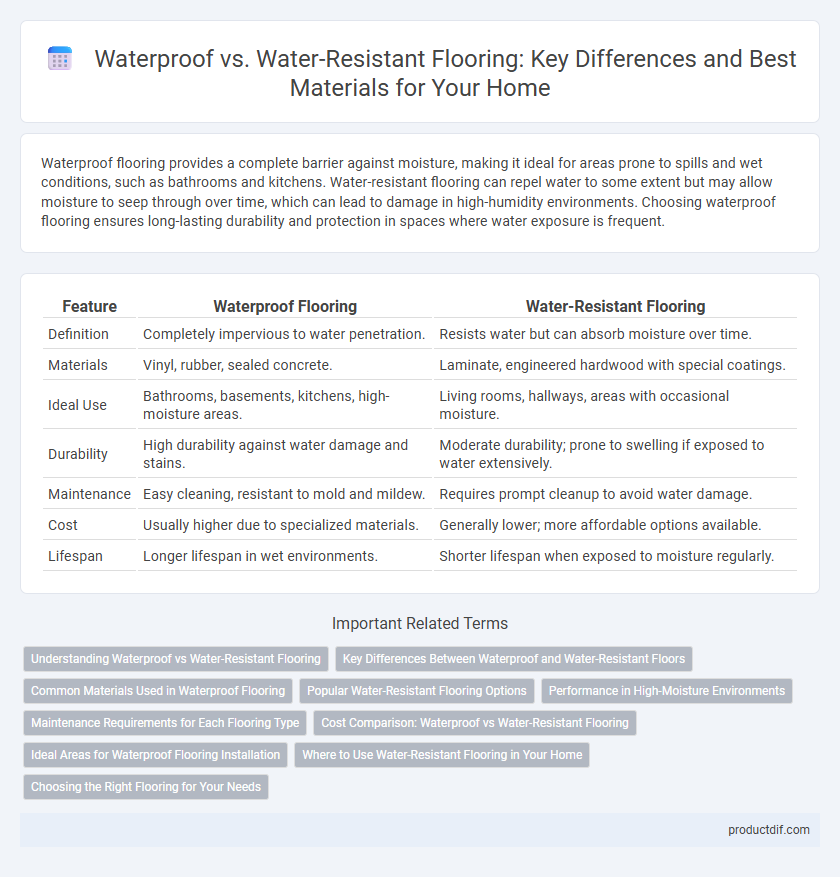Waterproof flooring provides a complete barrier against moisture, making it ideal for areas prone to spills and wet conditions, such as bathrooms and kitchens. Water-resistant flooring can repel water to some extent but may allow moisture to seep through over time, which can lead to damage in high-humidity environments. Choosing waterproof flooring ensures long-lasting durability and protection in spaces where water exposure is frequent.
Table of Comparison
| Feature | Waterproof Flooring | Water-Resistant Flooring |
|---|---|---|
| Definition | Completely impervious to water penetration. | Resists water but can absorb moisture over time. |
| Materials | Vinyl, rubber, sealed concrete. | Laminate, engineered hardwood with special coatings. |
| Ideal Use | Bathrooms, basements, kitchens, high-moisture areas. | Living rooms, hallways, areas with occasional moisture. |
| Durability | High durability against water damage and stains. | Moderate durability; prone to swelling if exposed to water extensively. |
| Maintenance | Easy cleaning, resistant to mold and mildew. | Requires prompt cleanup to avoid water damage. |
| Cost | Usually higher due to specialized materials. | Generally lower; more affordable options available. |
| Lifespan | Longer lifespan in wet environments. | Shorter lifespan when exposed to moisture regularly. |
Understanding Waterproof vs Water-Resistant Flooring
Waterproof flooring entirely prevents water penetration, making it ideal for areas prone to moisture like bathrooms and basements, whereas water-resistant flooring only delays water absorption but can still be damaged by standing water. Materials such as vinyl planks and certain tiles are typically waterproof, offering complete protection against spills and humidity. In contrast, water-resistant options, like some laminate or engineered wood floors, resist minor splashes but require prompt drying to avoid warping or swelling.
Key Differences Between Waterproof and Water-Resistant Floors
Waterproof flooring completely prevents water penetration, making it ideal for moisture-prone areas like bathrooms and basements, whereas water-resistant flooring only offers partial protection against spills and humidity. Waterproof materials such as vinyl and certain laminates have sealed seams and coatings that block all water ingress, while water-resistant options like engineered wood or treated hardwood resist moisture but can still absorb some water over time. Choosing between waterproof and water-resistant flooring depends on exposure to water and maintenance preferences, with waterproof floors providing superior durability in wet conditions.
Common Materials Used in Waterproof Flooring
Waterproof flooring commonly utilizes materials such as luxury vinyl planks (LVP), ceramic or porcelain tiles, and sealed concrete, each designed to prevent water infiltration entirely. Luxury vinyl planks feature a dense core and waterproof wear layer, making them ideal for bathrooms and basements where moisture exposure is frequent. Porcelain tiles offer a highly durable, non-porous surface that resists water and staining, while sealed concrete provides a solid, impermeable base that guards against water damage in high-moisture areas.
Popular Water-Resistant Flooring Options
Popular water-resistant flooring options include luxury vinyl plank (LVP), laminate with water-resistant coatings, and engineered hardwood treated with protective finishes. These materials prevent moisture penetration to a degree, making them suitable for kitchens, bathrooms, and basements where occasional spills or humidity occur. Water-resistant flooring offers a budget-friendly, stylish solution combining durability with moderate protection against water damage.
Performance in High-Moisture Environments
Waterproof flooring provides an impermeable barrier that prevents water penetration, making it ideal for high-moisture environments such as bathrooms, kitchens, and basements. Water-resistant flooring resists moisture to a certain degree but may allow water to seep through if exposed for extended periods, requiring careful maintenance to avoid damage. Choosing waterproof flooring materials like vinyl, ceramic tile, or sealed laminate enhances durability and protects subfloors in consistently damp or wet conditions.
Maintenance Requirements for Each Flooring Type
Waterproof flooring, such as vinyl or ceramic tile, requires minimal maintenance beyond regular cleaning since it resists moisture intrusion and prevents water damage. Water-resistant flooring options, including engineered hardwood and laminate, need more cautious upkeep to avoid prolonged exposure to water, as they can swell or warp if moisture penetrates the surface. Routine sweeping and promptly wiping spills are essential for both types, but water-resistant flooring demands additional protective measures like waterproof sealants or mats in high-moisture areas.
Cost Comparison: Waterproof vs Water-Resistant Flooring
Waterproof flooring typically costs between $3 and $7 per square foot, offering a higher upfront investment due to its advanced protective layers and materials like vinyl or rubber. Water-resistant flooring, often made from treated laminates or engineered wood, ranges from $2 to $5 per square foot, making it a more budget-friendly option for areas with minimal moisture exposure. Choosing between waterproof and water-resistant flooring depends on balancing initial expenditure with expected durability against water damage.
Ideal Areas for Waterproof Flooring Installation
Waterproof flooring is ideal for high-moisture areas such as bathrooms, kitchens, basements, and laundry rooms where water exposure is frequent and prolonged. Unlike water-resistant flooring, it prevents water from seeping through seams and subfloors, protecting against mold and structural damage. Luxury vinyl planks, ceramic tiles, and certain sealed hardwoods are popular waterproof flooring options that ensure durability and longevity in these environments.
Where to Use Water-Resistant Flooring in Your Home
Water-resistant flooring is ideal for areas in your home where occasional moisture exposure occurs, such as kitchens, dining rooms, and entryways. This type of flooring provides a durable surface that can withstand spills and humidity without compromising structural integrity. Choosing water-resistant materials like vinyl or laminate enhances protection while maintaining aesthetic appeal in these moderate moisture environments.
Choosing the Right Flooring for Your Needs
Waterproof flooring prevents water from penetrating the surface completely, making it ideal for high-moisture areas like bathrooms and basements. Water-resistant flooring provides a barrier against minor spills and humidity but may be damaged by standing water, suitable for kitchens and living rooms. Selecting the right flooring depends on the environment's moisture level and the flooring's ability to withstand water exposure over time.
Waterproof Flooring vs Water-Resistant Flooring Infographic

 productdif.com
productdif.com